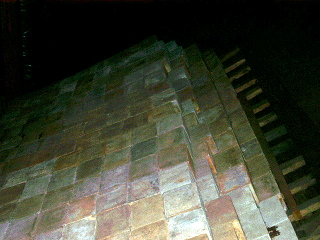 According to Sailing Today, September 2000 page 83, Van de Stadt’s Dehler 25 sloop bested MacGregor Yachts by a year or so in the use of water ballast. The German Dehler 25s were produced from 1984 to 1991 and water ballast was reported in the US to be used for trailering reasons and cost savings. With the Van De Stadt Swing Rig Patent, I have come to doubt the reports involving cost.Dahler appears to be more interested in innovation than cost savings. The notion that lower cost always translates into mediocre quality (a notion that I do not hold) may support this myth. There is also the belief that any bilge ballast (water or otherwise) represents a failure by the architect/ builders. When a boat is launched and floats above her lines, correction is made by adding bilge ballast. Later, certainly before the boat is resold or perhaps during haul out, the bilge ballast might be tacked to the vessels keel where the design flaw isn’t so visible and is even harmful.
According to Sailing Today, September 2000 page 83, Van de Stadt’s Dehler 25 sloop bested MacGregor Yachts by a year or so in the use of water ballast. The German Dehler 25s were produced from 1984 to 1991 and water ballast was reported in the US to be used for trailering reasons and cost savings. With the Van De Stadt Swing Rig Patent, I have come to doubt the reports involving cost.Dahler appears to be more interested in innovation than cost savings. The notion that lower cost always translates into mediocre quality (a notion that I do not hold) may support this myth. There is also the belief that any bilge ballast (water or otherwise) represents a failure by the architect/ builders. When a boat is launched and floats above her lines, correction is made by adding bilge ballast. Later, certainly before the boat is resold or perhaps during haul out, the bilge ballast might be tacked to the vessels keel where the design flaw isn’t so visible and is even harmful.
The notion that external keel ballast in any form is a flaw rather than a feature would not be a surprise to a sailor from 100 years ago. This trick of tacking lead on the external keel has probably been a joke among sailing work-boat owners for at least that long. Weight on a foil external to the hull creates a lever that the sea over time will use to crack the hull. I have chatted with two over 20 year old fiberglass sail boat owners who have experienced this cracking. They report that their vessels had not been grounded. Just sea action caused the cracks.
 Prior to about 1900, all sailing vessels used internal (also called bilge) ballast in the form of cargo, stone and, as in the case of Spray, concrete. Spray continues to be disparaged as a cheep boat because of her ballast. Yet this method of ballasting has been proven by time. Oriole is a 1918 George Owen (of MIT) racing yacht that was intended to be the largest yacht on the Great Lakes. She is larger than the current day maxis at 102 foot over all and 91 foot at the water line. The way to honor the sailors of the past is to preserve their vessels and in 2003 Oriole underwent a major overhaul. The most significant make over was the removal of CONCRETE ballast which was replaced with lead. Over the years Oriole gained a following among the less “yachty” and became known as the peoples boat. However it must have been distressing to the well heeled to have a concrete ballasted vessel better them. Oriole came in second in the 1998 Victoria-Maui race and in 2000 finished more than 19 hours ahead on corrected time over some of the most modern race boats on the Pacific.
Prior to about 1900, all sailing vessels used internal (also called bilge) ballast in the form of cargo, stone and, as in the case of Spray, concrete. Spray continues to be disparaged as a cheep boat because of her ballast. Yet this method of ballasting has been proven by time. Oriole is a 1918 George Owen (of MIT) racing yacht that was intended to be the largest yacht on the Great Lakes. She is larger than the current day maxis at 102 foot over all and 91 foot at the water line. The way to honor the sailors of the past is to preserve their vessels and in 2003 Oriole underwent a major overhaul. The most significant make over was the removal of CONCRETE ballast which was replaced with lead. Over the years Oriole gained a following among the less “yachty” and became known as the peoples boat. However it must have been distressing to the well heeled to have a concrete ballasted vessel better them. Oriole came in second in the 1998 Victoria-Maui race and in 2000 finished more than 19 hours ahead on corrected time over some of the most modern race boats on the Pacific.
After many stinging comments from those who believed me incapable of understanding this ballast business, I was pointed toWoodenBoats November/December 2000 issue which has been the most helpful article I have come across in refuting sailing myths. I keep that now with my Mac26x owners guide, and thank the wooden boat building enthusiasts for advancing the use of water ballast, and showing me that I am capable of seeing some sailing truths, where more experienced sailors may not. To quantify things, water ballasted designs like the Mac26x, where the ballast is located as far outboard as possible, are roughly four times more stable at 10 degrees of heel, three times more stable at 30 degrees, and twice as stable at 50 degrees than similer vessels with weighted centerline keels. (see G$ 24) The off centerline as far as possible arrangement lowers the center of gravity and “maximizes stability at low heel angles, since the flotation effect of the windward keel is quickly lost if the boat heels enough to pull it from the water. This is exactly like a catamaran.” Oriole came in second in the 1998 Victoria-Maui race and in 2000 finished more than 19 hours ahead on corrected time over some of the most modern raceboats on the Pacific. In 1998 she finished seventh in the Sydney-Hobart.
This was the infamous race where 55 people had to be rescued, 5 boats sank, and 66 boats retired out of the 115 that started, 6 sailor’s lives were lost during that race. To say the Oriole’s design is proven, understates the contributions she has made to the science of sailing. The 102 ft ketch is currently owned by the Canadian Navy and is used for training of Regular and Reserve Canadian Navy members. It is distressing to those who would like to think of Oriole as the people’s boat to have the concrete removed and replaced with an expensive substitute that has not been shown any more effective.
Often, when a material is inexpensive and is used in boat manufacturing, there is an assumption by those not making a livelihood from the sea, that the boat is not seaworthy. Cost is not the most important factor in seaworthiness. The notion that the least cost ballast, water, and water in movable form (caskets) was used by almost all square riggers should distress those advocating external movable (canting) bulb ballasted keels which are competing with movable water ballast designs.
In spite of the availability of movable keels for over a decade now, movable water ballast continues to be used in the single handled ocean racing sailboats where cost is not a concern. Where the canting keel sailing machine may better in normal wind behind her she suffers in light wind because the canting keel form of movable ballast can not be moved off the vessel.
Movable water ballast represents the better sail boat design philosophy.



Water Ballast | Cruising Log of the Murrelet http://t.co/GmnR7F380X #sailing via @mighetto1